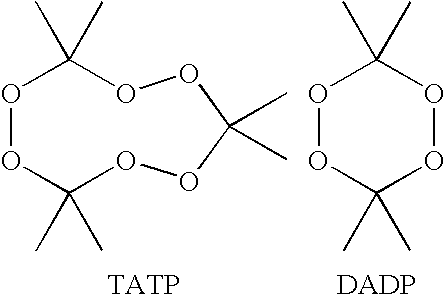Simulant material for primary explosives
a technology of simulant material and primary explosives, applied in the field of simulant material for primary explosives, can solve the problems of high risk of detonation, inability to train sniffer dogs with live explosives on site, and inability to achieve correct training procedures for sniffer dogs using large amounts of explosives, so as to reduce the sensitivity
- Summary
- Abstract
- Description
- Claims
- Application Information
AI Technical Summary
Benefits of technology
Problems solved by technology
Method used
Image
Examples
Embodiment Construction
[0049]The present invention provides a material for use as a simulant for primary explosives, which use and application has thus far been avoided in the training of humans and sniffing animals. As will be demonstrated herein with respect to TATP, such a reduction in the sensitivity of primary explosives now allows their use in the field as well as on-site where the sniffing animal is to be assigned to.
[0050]Acetone peroxide, also known as triacetone triperoxide and TATP, is a white crystalline organic trimer-peroxide of acetone that is highly unstable and, as a result, has been categorized as a primary explosive.
[0051]TATP is one of the most sensitive solid explosives known, being extremely sensitive to impact, temperature change and friction. Despite its known use by suicide bombers, it has sprung into notoriety only recently due to its alleged use in detonators by the 2001 thwarted “shoe bomber” Richard Reid. It has additionally been used as the primary explosive in the July 2005 ...
PUM
| Property | Measurement | Unit |
|---|---|---|
| concentration | aaaaa | aaaaa |
| volatile | aaaaa | aaaaa |
| flexible | aaaaa | aaaaa |
Abstract
Description
Claims
Application Information
 Login to View More
Login to View More - R&D
- Intellectual Property
- Life Sciences
- Materials
- Tech Scout
- Unparalleled Data Quality
- Higher Quality Content
- 60% Fewer Hallucinations
Browse by: Latest US Patents, China's latest patents, Technical Efficacy Thesaurus, Application Domain, Technology Topic, Popular Technical Reports.
© 2025 PatSnap. All rights reserved.Legal|Privacy policy|Modern Slavery Act Transparency Statement|Sitemap|About US| Contact US: help@patsnap.com

